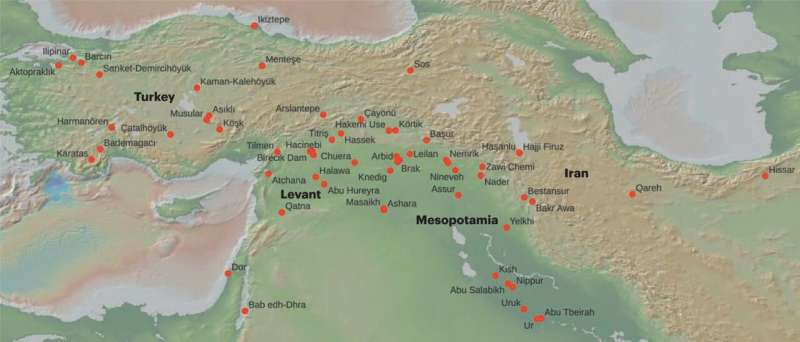The development of the earliest cities in Mesopotamia and the Middle East led to a substantial increase in violence between inhabitants. Laws, centralized administration, trade and culture then caused the ratio of violent deaths to fall back again in the Early and Middle Bronze Age (3,300 to 1,500 BCE). This is the conclusion of an international team of researchers from the Universities of Tübingen, Barcelona and Warsaw. Their results were published in Nature Human Behaviour.
The researchers examined 3,539 skeletons from the region that today covers Iran, Iraq, Jordan, Syria, Lebanon, Israel and Turkey for bone trauma which could only have occurred through violence. This enabled them to draw a nuanced picture of the development of interpersonal violence in the period 12,000 to 400 BCE. The period was characterized by such fundamental changes in human history as the development of agriculture, leaving behind the nomadic lifestyle, and the building of the first cities and states.
“The ratio of interpersonal violence—i.e. of murder—peaked in the period of 4,500 to 3,300 years BCE and then fell back again over the course of the next 2,000 years,” says Joerg Baten from the Chair of Economic History at the University of Tübingen, who is the study’s project manager.
“With the climate crisis, growing inequality and the collapse of important states in the Late Bronze Age and Early Iron Age (1,500–400 BCE), violence increased once more.” The proportion of violent deaths, identifiable by cranial trauma and injuries from weapons (e.g. arrow heads in skeletons), is a common benchmark used to assess interpersonal violence.

Distribution of Middle Eastern archaeological sites that provided bioarchaeological evidence for the present study. © Nature Human Behaviour (2023). DOI: 10.1038/s41562-023-01700-y
Until now, research into this has divided into two camps. One, epitomized by American psychologist Steven Pinker, claims a steady reduction in the use of violence over the millennia from the era of hunter-gatherer societies to today. The other regards the development of cities and a central power as the precondition for wars and massive use of violence, which has continued since then. The study produced by Tübingen, Barcelona and Warsaw now gives a more nuanced picture.
The researchers put the increase in violence in the 5th and 4th millennia BCE down to the agglomeration of humans in the first, still poorly organized, cities. The rate of violence only reduced significantly once legal systems, a centrally controlled army, and religious institutions (for example, religious festivals) developed. Trade also increased in the eastern region of the Mediterranean and Mesopotamia in the Early and Late Bronze Age, as can be seen from clay tablets with cuneiform script, which were used as delivery notes and invoices.
“The greater security in this period was initially possible even despite declining agricultural yields and a growing inequality in incomes in the Middle Bronze Age,” says Giacomo Benati from the University of Barcelona, co-author of the study.
Another turning point was the collapse of many advanced civilizations in the Late Bronze Age. At this stage, around 1,200 BCE, there was also a climate catastrophe lasting 300 years, associated with migratory movements. This again led to an increase in the ratio of violent deaths.
More information:
Joerg Baten et al, Violence trends in the ancient Middle East between 12,000 and 400 bce, Nature Human Behaviour (2023). DOI: 10.1038/s41562-023-01700-y
Provided by
University of Tübingen
Citation:
Research finds dramatic increase in cranial traumas as the first cities were being built, suggesting a rise in violence (2023, October 10)



